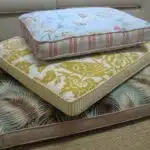As textile care specialists, we understand the importance of maintaining a clean and pristine environment for our clients. One of the most crucial aspects of this is ensuring that their bedding and linens are fresh and hygienic. Proper cleaning and care is not only vital for maintaining the appearance and longevity of these items, but also for ensuring the health and well-being of those who use them.
In this article, we will provide you with comprehensive guidance on how to effectively clean and care for your sheets and bed linens. We will cover everything from selecting the right detergent to understanding the various fabric types, as well as providing tips on how to remove common stains. Whether you are a professional cleaner or simply someone who wants to maintain a high standard of cleanliness in their home, this guide is an essential resource for anyone looking to keep their sheets and linens in top condition.
The Importance Of Proper Sheet And Bed Linen Care
As a textile care specialist, I have seen countless cases of poorly maintained bedding. It is astonishing how many people neglect proper sheet and bed linen care when it can save them so much money in the long run. The benefits of using high-quality bedding are undeniable, but without proper maintenance, these benefits become short-lived.
One of the most significant benefits of using high-quality bedding is that it improves one’s sleep quality. When you invest in luxurious, comfortable sheets, you will wake up feeling refreshed and energized, ready to tackle your day. However, if you do not take care of your bedding properly, you will not experience these benefits for long.
Tips for extending the lifespan of your sheets include washing them frequently and with care. Use cold water instead of hot water to avoid shrinking or damaging the fibers. Also, avoid using harsh detergents or bleaches that can weaken the fabric over time. Line-drying or tumble-drying on low heat are the best options for drying your sheets as they help maintain their shape and texture.
Understanding different fabric types is essential to ensure that you are caring for your sheets correctly. In the next section, we will discuss various fabrics commonly used in bedding and how to take care of each type properly. By following these tips and understanding different fabric types, you can extend the life of your sheets and enjoy a restful night’s sleep every night.
Understanding Different Fabric Types
Proper sheet and bed linen care is essential to maintain the quality and longevity of your bedding. In the previous section, we discussed the importance of proper sheet and bed linen care. Now, let’s dive deeper into understanding different fabric types and fabric care tips.
Understanding fabric types is crucial in maintaining your bedding. The most common types of fabrics used for sheets include cotton, linen, silk, and microfiber. Each fabric type has its unique characteristics that require specific care instructions. Cotton is a popular choice because it is durable, breathable, and easy to care for. On the other hand, silk requires delicate handling as it can easily snag or shrink if not washed properly.
When it comes to fabric care tips, it is important to read and follow the manufacturer’s instructions carefully. Use a gentle cycle with cold water when washing your sheets to prevent damage or shrinkage. Avoid using bleach or harsh detergents as they can weaken the fibers in your sheets over time. Instead, opt for mild detergents that are specifically formulated for delicate fabrics.
Understanding fabric types and following proper fabric care tips will help you maintain the quality of your bedding for years to come. In the next section, we will discuss selecting the right detergent that works best for each fabric type.
Selecting The Right Detergent
Did you know that the average American household does eight to ten loads of laundry per week? That’s a lot of detergent! When it comes to selecting the right detergent for your sheets and bed linens, there are a few things to consider. Firstly, it’s important to choose eco-friendly options that avoid harsh chemicals. These chemicals can cause skin irritation and allergic reactions in some individuals, and they can also be harmful to the environment.
When searching for an eco-friendly detergent, look for products that have been certified by third-party organizations such as the Environmental Protection Agency or the Green Seal. These certifications ensure that the product has been tested and meets specific standards for environmental safety. Additionally, consider using natural detergents made from plant-based materials, which are gentler on your skin and less damaging to the environment.
Another option is to make your own laundry detergent using simple ingredients like baking soda, washing soda, and castile soap. This DIY approach not only allows you to control what goes into your detergent but also reduces packaging waste and saves money in the long run. By choosing eco-friendly options and avoiding harsh chemicals, you’ll not only protect yourself but also contribute positively towards creating a healthier environment.
As we’ve discussed, selecting the right detergent is key when it comes to cleaning and caring for your sheets and bed linens. However, it’s not just about choosing the right product – it’s also important to use it correctly. In our next section, we’ll explore temperature and water settings for washing your bedding in more detail. Understanding how these factors impact your linens will help you achieve optimal cleaning results while prolonging their lifespan.
Temperature And Water Settings For Washing
After selecting the right detergent, it’s time to move on to the next essential step in caring for your sheets and bed linens. Water temperature is critical when it comes to washing these items. Too hot or too cold water can cause damage to delicate fabrics and lead to shrinkage or fading of colors. It is recommended that you use warm water, which is around 40 degrees Celsius, for most types of bed linen.
When washing your sheets and bed linens, be mindful of the type of fabric they are made of. Some fabrics require special care, such as silk or linen. For these fabrics, it may be necessary to use cooler water temperatures than usual or even hand wash them instead of using a machine. Always refer to the care label on your bedding for specific instructions on how best to clean them.
Here are some additional tips you should keep in mind when washing your bed linens:
- Avoid overloading the washing machine as this can cause tangling and damage.
- Use a gentle cycle setting if possible.
- Do not bleach unless specified on the care label.
- Be careful when drying delicate fabrics in a tumble dryer as high heat can cause shrinkage.
Properly cleaning and caring for your sheets and bed linens takes time and effort but will ensure that they last longer and stay looking great over time. In our next section, we will cover an essential step in keeping your bedding soft and comfortable – using fabric softeners and conditioners.
Using Fabric Softeners And Conditioners
Fabric softeners and conditioners are popular laundry products that can make your bed linens feel silky, smooth, and fresh. They are designed to coat the surface fibers of the fabric with a thin layer of chemicals that reduce static cling, soften rough textures, and leave a pleasant scent. However, while they may offer some benefits, there are also some drawbacks to using them.
Benefits include softer and more comfortable sheets and linens, reduced wrinkles in fabrics after washing, and eliminating static cling that can be troublesome for some people. Additionally, fabric softeners often leave behind a pleasant fragrance on the bedding which can help you relax at night. However, one drawback is that they can be costly over time as you need to purchase them frequently. Some people may also experience skin irritation from the chemicals used in these products.
If you’re looking for alternatives to fabric softeners and conditioners, there are several options available. One is to use dryer balls made from wool or other natural materials instead of dryer sheets. These work by bouncing around in the dryer and separating the clothes so they dry faster which reduces static cling without leaving any residues on the fabric. Another alternative is to use white vinegar or baking soda as natural fabric softeners during the wash cycle. These ingredients help neutralize odors in fabrics while also softening them.
In conclusion, while fabric softeners and conditioners do offer some benefits such as softer bedding and reduced static cling, there are also drawbacks such as cost and potential skin irritation. If you’re looking for alternatives, consider using dryer balls or natural ingredients like vinegar or baking soda as alternative solutions for softer linens without any negative side effects. In our subsequent section about bleaching and whitening agents we will discuss how to keep your bedding bright white without damaging the fibers of the fabric through harsh chemicals.
Bleaching And Whitening Agents
Bleaching and whitening agents are commonly used to remove tough stains and keep bed linens looking bright and fresh. However, it is important to use these products properly to avoid damaging the fabric. Before using any bleach or whitening agent, always check the care label on your linens to ensure that they can handle the treatment.
Types of stains that may require bleaching or whitening agents include blood, sweat, urine, and food stains. Chlorine bleach is a popular choice for removing these types of stains, but it can weaken fabric fibers over time if used excessively. Alternatives to bleach include hydrogen peroxide, vinegar, baking soda, and lemon juice. These options are gentler on fabrics but may not be as effective at removing tough stains.
When using bleach or other whitening agents, always follow the instructions on the product label carefully. Avoid mixing different types of cleaning agents as this can create dangerous chemical reactions. It is also important to rinse bed linens thoroughly after using bleach or any other cleaning product to remove any residue that could irritate your skin.
Next up are drying techniques and tips for keeping your sheets looking their best!
Drying Techniques And Tips
After washing your bed linens, it is important to dry them properly to avoid any damage or shrinkage. One of the best ways to dry bed linens is by air-drying. This method involves hanging your sheets outside on a clothesline or drying rack. Make sure that you hang them in a well-ventilated area away from direct sunlight to prevent fading. If you live in a humid area, it may take longer for them to dry completely.
Another way to air-dry your sheets is by laying them flat on a clean, dry surface such as a table or countertop. This method helps prevent shrinkage and wrinkles by allowing the fabric to stretch out evenly. Flip the sheets over occasionally to ensure they dry evenly on both sides. While this method may take longer than using a dryer, it is gentler on the fabric and helps prolong their lifespan.
Preventing shrinkage is crucial when caring for bed linens. To avoid this problem, never use high heat in the dryer or iron directly onto damp fabric. If you choose to use a dryer, set it on low heat or tumble dry with no heat at all. This will help protect your sheets from shrinking or becoming damaged during the drying process.
As air-drying methods are gentle on fabrics and can help preserve their quality, it’s an ideal technique for extending the life of your bedding. However, if you prefer the crisp look and feel of ironed linen, we’ll explore some ironing and steaming methods in the next section that can help achieve this without damaging your bedding.
Ironing And Steaming Methods
After the sheets and bed linens have been adequately dried, it is essential to iron or steam them for a crisp finish. Ironing and steaming are two popular techniques used to care for bed linens. Both methods have their pros and cons, but each technique ultimately serves the same purpose of providing well-maintained sheets.
Ironing is a traditional method that involves pressing down on the fabric with a hot iron to remove wrinkles. The benefits of ironing include that it creates sharp creases, eliminates tough wrinkles, and leaves a polished finish. However, ironing can be time-consuming, especially when dealing with large bed linens. Additionally, incorrect temperature settings or prolonged exposure to heat may result in scorch marks or damage to the fabric.
On the other hand, steaming has become increasingly popular due to its convenience and effectiveness in removing wrinkles. Steaming bed linens is more comfortable than ironing because it does not require any physical effort or pressure onto the fabric. Steaming also sanitizes bedding by killing dust mites and bacteria that may be present. However, steaming can leave bedding damp if not done correctly, which could lead to mildew growth if not dried correctly.
Best practices for both techniques include using distilled water to avoid mineral buildup in appliances and choosing an appropriate temperature setting according to the fabric’s material type. Ultimately, whether you choose ironing or steaming depends on your preferences and needs.
Transition: As much as we try our best to keep our bedding free from stains, accidents happen. The next section will discuss common issues encountered with stains on bedding and how to remove them effectively without compromising the quality of your sheets.
Stain Removal For Common Issues
Removing Stains for Common Issues
Stains are inevitable when it comes to bed linens, but they don’t have to be permanent. It’s crucial to remove stains as soon as possible to prevent them from setting into the fabric. The first step is to identify the type of stain before choosing an appropriate cleaning solution. For example, protein-based stains such as blood and sweat require a different approach than oil-based stains like makeup and lotion.
Preventative measures can go a long way in keeping your sheets and bed linens stain-free. Avoid eating or drinking in bed, and always remove your makeup before going to sleep. Additionally, consider using a mattress protector to prevent spills from seeping through your sheets onto your mattress. Remember that prevention is key in avoiding unsightly stains on your bedding.
If you do find yourself with stained sheets, there are several methods for removing them. One popular option is using hydrogen peroxide mixed with dish soap and baking soda for tough protein-based stains. For oil-based stains, try using rubbing alcohol or white vinegar mixed with water. Always spot test an inconspicuous area of your bedding before applying any cleaning solution to avoid damaging the fabric.
Next up: Dealing with Odors and Mildew
Dealing With Odors And Mildew
After tackling common stain issues on bed linens, the next step in maintaining their quality is to address any odors and mildew stains. These are common problems that can arise from improper storage or infrequent washing. Mildew is a fungus that thrives in warm, damp environments, making it a particular issue for bed linens.
To remove mildew stains, begin by washing the affected linens in hot water with a cup of white vinegar added to the cycle. This will help kill any remaining spores and prevent them from spreading further. If the stain persists, try soaking the linens overnight in a mixture of equal parts hydrogen peroxide and water before washing as usual.
Preventing odors in bed linens can be achieved by following some simple guidelines. Allow your sheets to air out each morning by pulling them back and exposing them to fresh air and sunlight if possible. Avoid using fabric softeners or dryer sheets which can leave a coating on the fibers that traps odor molecules. Finally, consider rotating your bedding frequently to allow each set ample time between uses to air out completely.
As textile care specialists, maintaining the quality of bed linens is our top priority. Removing mildew stains and preventing odors is crucial to ensuring long-lasting comfort and cleanliness for our customers. In the next section, we will provide some storage and organization tips that will further aid in this endeavor.
Storage And Organization Tips
As important as it is to know how to clean and care for sheets and bed linens, it is equally crucial to know how to store and organize them properly. One theory that has been circulating around is that folding fitted sheets in a perfect square shape can make them easier to stack and store. However, this claim is not entirely true. It is better to fold fitted sheets into rectangles or long strips, allowing them to fit more easily into storage containers.
Maximizing space in your linen closet or dresser drawers can be achieved through creative folding techniques. For example, instead of simply folding flat sheets in half, try the “KonMari Method” by folding them into thirds vertically and then horizontally. This technique creates a compact square that can be easily stacked on top of other linens without taking up too much space.
Another way to maximize space is by using adjustable shelf dividers in your linen closet or dresser drawers. These dividers allow you to customize the height of each shelf or drawer compartment, making it easier to stack linens without them toppling over. Additionally, using clear storage containers with labels can help you quickly find the linens you need without having to dig through piles of sheets.
Transitioning into the subsequent section about frequency of cleaning and replacement, it’s important to note that proper storage and organization can also extend the lifespan of your bedding. By keeping your linens neatly folded and stored away from sunlight and moisture, you can reduce wear and tear on the fabric. However, even with proper care, bedding should still be cleaned regularly and replaced every few years for optimal hygiene and comfort.
Frequency Of Cleaning And Replacement
- Cleaning frequency for sheets and bed linens should be dependent on the type of material and the amount of use.
- Generally, sheets should be washed at least once a week and bed linens should be washed every two to four weeks.
- Natural fabrics should be washed on a gentle cycle with a mild detergent, while synthetic fabrics should be washed on a normal cycle with a detergent designed for synthetic fibers.
- In addition, sheets and bed linens should be replaced as soon as holes, tears, or other signs of wear appear.
- To maintain the look and longevity of sheets and bed linens, it is recommended to only use detergents and fabric softeners that are free of bleach or optical brighteners.
- To prevent fading and discoloration, it is also important to follow the manufacturer’s instructions for drying, ironing, and storing sheets and bed linens.
Frequency Of Washing
As a textile care specialist, it is important to understand how often sheets and bed linens should be washed. Some people may think that infrequent washing provides benefits such as saving time and preserving the fabric quality. However, this is not entirely true. Infrequent washing can lead to an accumulation of sweat, dirt, and bacteria on the sheets which can cause skin irritation, allergies, and even infections.
In general, it is recommended to wash sheets and bed linens once a week. Pillows should also be washed every six months to remove dead skin cells, dust mites, and other allergens that may accumulate over time. It is important to follow the care label instructions for each type of fabric to prevent damage or shrinkage during the washing process.
By adhering to a regular schedule of washing sheets and bed linens, you can maintain good hygiene practices and improve your overall sleep quality. As a textile care specialist, I highly recommend investing in high-quality bedding materials that are durable and easy to clean. With proper care and maintenance, your sheets will last longer and provide you with a comfortable sleeping environment for years to come.
Frequency Of Replacing
As a textile care specialist, it is important to not only understand how frequently sheets and bed linens should be washed but also when they should be replaced. While regular washing can help maintain hygiene and prolong the lifespan of bedding materials, it’s essential to recognize the signs of wear and tear that indicate the need for replacement.
Bedding materials such as pillows, comforters, and mattress toppers should be replaced every 1-2 years depending on their quality and usage. Signs of wear may include flattened or lumpy filling, noticeable stains or tears, or an unpleasant odor that cannot be eliminated through washing. Additionally, if you have recently recovered from an illness or infection, it’s recommended to replace your bedding materials to prevent reinfection.
When it comes to mattresses, the lifespan varies depending on the material and quality. In general, a good-quality mattress can last up to 10 years with proper care and maintenance. Signs that indicate a need for replacement include sagging or unevenness in the surface, visible damage such as holes or tears in the fabric cover, or if you are experiencing discomfort or pain while sleeping.
By understanding when to replace bedding materials based on their wear and tear, you can ensure a comfortable and hygienic sleeping environment while also maximizing your investment in quality bedding. As a textile care specialist, I recommend regularly inspecting your bedding materials for signs of damage or wear and replacing them as needed to maintain optimal sleep health.
Types Of Detergent To Use
As a textile care specialist, it’s important to not only know when to replace bedding materials but also how to properly clean them. Using the right detergent is crucial in maintaining the quality and lifespan of your bedding. When choosing a detergent, consider eco-friendly options that are gentle on both your bedding and the environment. These detergents often contain natural ingredients that are free from harsh chemicals, making them a great option for those with sensitive skin.
Sensitive skin considerations should also be taken into account when selecting a detergent. Some people may experience skin irritation or allergic reactions from certain ingredients commonly found in traditional laundry detergents. To avoid this, opt for hypoallergenic and fragrance-free detergents that are specifically designed for sensitive skin. These detergents are milder than traditional ones and can help reduce the risk of skin irritation or rashes.
In summary, using the right type of detergent is essential in maintaining the quality and hygiene of your bedding while also considering eco-friendly options and sensitive skin considerations. By taking these factors into account when doing laundry, you can ensure that your bedding materials remain clean, fresh, and comfortable for years to come.
Environmental Considerations For Textile Care
As textile care specialists, we are not only concerned with the cleanliness and maintenance of bed linens, but also with the environmental impact of our practices. In recent years, there has been a growing emphasis on eco-friendly products and sustainable laundry practices. This includes using detergents that are free of harmful chemicals and reducing water and energy usage.
When it comes to choosing laundry detergent, look for products that are biodegradable and free of harsh chemicals such as phosphates, surfactants, and optical brighteners. These ingredients can be harmful to aquatic life and may have negative effects on the environment. Eco-friendly options such as plant-based or natural detergents can be just as effective while being gentler on the planet.
Sustainable laundry practices involve reducing water usage by washing clothes in cold water when possible, opting for shorter wash cycles, and air-drying instead of using a dryer. Investing in energy-efficient appliances can also make a significant impact in reducing your household’s carbon footprint. By incorporating these practices into your textile care routine, you can contribute to creating a healthier planet for future generations.
To continue on the path of sustainable living, it is important to consider all aspects of textile care including the materials used in bedding and linens. In the next section, we will explore how choosing the right bedding and linens for your needs can not only enhance your sleeping experience but also have a positive impact on the environment.
Choosing The Right Bedding And Linens For Your Needs
As a textile care specialist, it cannot be emphasized enough how crucial it is to choose the right bedding and linens for your needs. The wrong choice can cause discomfort, poor sleep quality, and even skin irritation. When selecting bed linens, always consider the thread count. A higher thread count means a softer and more durable fabric that will last longer than lower thread counts. However, a higher thread count also means less breathability which can lead to overheating during warmer months.
Breathable fabrics are essential for promoting good sleep hygiene as they keep you comfortable throughout the night. Cotton is an excellent option as it is breathable and hypoallergenic. It absorbs moisture well and keeps you cool during hot weather while providing warmth in colder temperatures. Linen is another great option as it has natural cooling properties that make it ideal for summer use. Silk, on the other hand, provides luxurious softness but may require more care when washing.
Professional cleaning services and options are available for those who want to extend the life of their sheets and bedding. Dry cleaning is suitable for delicate fabrics such as silk or wool but may not be necessary for cotton or linen materials. It’s important to follow manufacturer instructions when washing at home to prevent damage or shrinkage of your bedding items. With proper care and maintenance, your bed linens can last longer while providing optimal comfort every time you lay down to rest.
Professional Cleaning Services And Options
When it comes to keeping your bed linens clean and fresh, professional dry cleaning services can provide a deep and thorough clean that is difficult to achieve at home. Professional dry cleaners use specialized equipment and techniques to remove dirt, stains, and odors from fabrics without causing damage or shrinkage. Additionally, the high heat used during the dry cleaning process can kill dust mites and other allergens that may be lurking in your sheets.
If you are concerned about the environmental impact of traditional dry cleaning methods, there are eco-friendly options available. Many dry cleaners now use non-toxic solvents or water-based cleaning methods that are gentler on both your linens and the environment. These cleaners may also offer reusable garment bags or hangers made from recycled materials as part of their commitment to sustainability.
Overall, professional cleaning services can be a great option for those who want to keep their bed linens looking and feeling like new. Whether you opt for traditional dry cleaning methods or more eco-friendly alternatives, these services can help extend the life of your sheets while providing a deep clean that is difficult to achieve at home.
Conclusion
Proper care and maintenance of sheets and bed linens is crucial to ensure their longevity, performance, and hygiene. Understanding the various types of fabrics and selecting the right detergent, water temperature, and fabric softeners are all essential components of maintaining the quality of your bedding. It’s also important to consider frequency of cleaning and replacement, as well as environmental impacts.
When selecting bedding and linens, it’s important to consider your specific needs and preferences in terms of style, comfort, and durability. Professional cleaning services can provide additional options for keeping your bedding in top condition.
As a textile care specialist, my goal is to educate consumers on the importance of proper sheet and bed linen care. By following these guidelines for washing, drying, storing and replacing your bedding as needed, you can enjoy a comfortable sleep environment that promotes good health while reducing your environmental impact.
So ask yourself: are you taking proper care of your sheets and bed linens? By investing time and effort into maintaining them properly, you can enjoy quality sleep that feels fresh every night. Don’t wait until it’s too late; start caring for your bedding today!
Image Credits
- “Linen Bedding with seashells” by DesignFolly.com (featured)














![How To Keep Sheets On A Bed: 10 Strategies 14 Bed sheets [Explored 2013-04-27]](https://green-life.blog/wp-content/uploads/2023/04/pH7FwL8jspjq-150x150.jpg.webp)














